
2
0
1
8
-0
7
42
Troubleshooting and Diagnosis
6.2
Device Internal Errors
The device detects internal error conditions that impact the following aspects:
■
Status information of cyclic data: For more information: configuration of cyclic
communication see chapter 4.2, cyclic communication data structure see chapter 4.4,
initialization run (valve coupler) see chapter 6.4.
■
Diagnostic content. For more information, see chapter 6.3.
■
COM ERR LEDs: For more information, see chapter 6.1.
6.3
Diagnosis
The PROFIBUS PA profile defines 2 different diagnostic modes supported by the device:
■
Classic diagnosis
■
Condensed diagnosis
The condensed diagnosis gives more structured and focused information of the device tailored
for the use in process systems and maintenance stations. You can adapt failure causes that
change the diagnostic state according to your needs. For more information, refer to the device
type manager (DTM).
Bytes 1
…
10 of the diagnostic extension and the diagnostic structures are identical.
The diagnostic mode can be changed via the device type manager (DTM) or via the
PRM_COND user parameter. The parameters are transmitted from the PROFIBUS host to the
device to during start-up of the device.
In the compatibility modes for FD0-BI-Ex12 and FD0-VC-Ex4.PA and the profile-3.02-specific
modes, only classic diagnosis is available. All other device modes support classical and
condensed diagnosis.
Error
Description
Impact on
Hardware IO
■
Internal communication
between fieldbus board
and IO board failed
■
Hardware error on
IO board
Condensed status:
■
Hardware error
Classic diagnosis:
■
Hardware error
Field diagnostics:
■
Device failure
LEDs:
■
COM ERR LED: ON
Hardware memory
■
Nonvolatile memory
verification failed
■
Nonvolatile memory write
access failed
Classic diagnosis:
■
Memory error
Field diagnostics:
■
Device failure
LEDs:
■
COM ERR LED: ON
















































